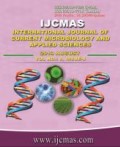


 National Academy of Agricultural Sciences (NAAS)
National Academy of Agricultural Sciences (NAAS)

|
PRINT ISSN : 2319-7692
Online ISSN : 2319-7706 Issues : 12 per year Publisher : Excellent Publishers Email : editorijcmas@gmail.com / submit@ijcmas.com Editor-in-chief: Dr.M.Prakash Index Copernicus ICV 2018: 95.39 NAAS RATING 2020: 5.38 |
A field experiment was conducted on rice (var. MTU-1001) by transplanting of 25 days seedlings during Kharif season 2018 in Inseptisols of Instructional cum Research Farm, S. G. College of Agriculture and Research Station, Kumhrawand, Jagdalpur, Chhattisgarh, India under RCBD (Randomized Complete Block Design) with four replications. The treatment combinations were Ambika paddy weeder at 20 and 40 day after transplanting, Bispyribac- sodium @ 80g ha-1 at 15 day after transplanting, hand weeding twice at 20 and 40 day after transplanting, water imponding of 40 days, 10 days after transplanting, no water imponding alongwith one control (no weeding). Plant height, LAI at 60 DAT, Tiller hill-1, Panicle hill-1, Penicle length (cm), Grains panicle-1, CGR (g plant-1 day-1) at 60-90 DAT, RGR (g plant-1 day-1) at 60-90 DAT were recorded higher value in hand weeding twice @ 20 and 40 days after transplanting than remaining treatments except bispyribac-sodium @ 80 g ha-1 at 15 DAT which was at par to that of hand weeding twice. Maximum number of panicle hill-1, panicle length, seeds panicle-1, and test weight were recorded with hand weeding twice @ 20 and 40 days after transplanting which was significantly superior over rest of treatments, being on par to application of bispyribac- sodium @ 80 g ha-1 at 15 days after transplanting. Hand weeding twice at 20 and 40 days after transplanting produced significantly higher grain yield (42.79 q ha-1) than rest of treatments except application of bispyribac- sodium @ 80 g ha-1 at 15 days after transplanting (40.31 q ha-1) which were 40.94% and 32.77% increased in yield over control. Among the treatments, the highest quantity of CO2 emission from rice field was with hand weeding twice at 20 and 40 DAT (2465.31 g day-1 ha-1) at 35 DAT and the lowest was recorded when applied bispyribac-sodium @ 80 g ha-1 at 15 DAT (202.98 g day-1ha-1) at 45 DAT, which was highest and lowest level of agronomical manipulations in respective treatments reflecting on emission.
 |
 |
 |
 |
 |